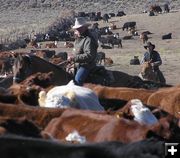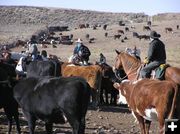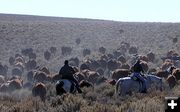

Sorting cattle
Richard Hulen looks for another as Dino Stauffer holds the herd. Pinedale Online file photo from 2004 fall drift.
|


The cutting grounds
The cutting grounds at Trappers Point. Pinedale Online file photo from 2004 fall drift.
|


Moving Sommers cattle
Wind River Cattle Drive: Albert Sommers, Barbara McKinley and Jamie Burgess. Pinedale Online file photo from 2004 fall drift.
|
|
Green River Drift nomination to the National Register moves forward
by Dawn Ballou, Pinedale Online!
February 27, 2012
On Friday, Feb. 24, the Wyoming National Register of Historic Places State Review Board met in Cheyenne to consider nominations to the National Register. The State Review Board discusses the eligibility of properties and makes recommendations regarding National Register nominations to the Wyoming State Historic Preservation Office (SHPO). One of the items on the agenda was the nomination of the Green River Drift in Sublette County to the National Register as a Traditional Cultural Property. After discussion, the Board voted to recommend approval of the nomination.
The Green River cattle drift has been used since 1896 and is still in use today as part of cattle operations for ranchers in the Upper Green River Valley. It is 67.8 miles long and has 31.5 miles of spur trails. For 115 years, it has been used by ranchers to get their cattle to and from range allotments in the Bridger-Teton National Forest in the Upper Green. The lower end of the Drift crosses the Mesa and the upper end of the Drift roughly follows Highway 352 north of Cora to the forest boundary. The cattle sorting grounds for the Drift are located near Trappers Point, just southwest of the US 191/Hwy 352 junction west of Pinedale.
Twice a year, in the spring and the fall, cattle move to and from area ranches to range allotments on the Bridger-Teton National Forest in the Upper Green. Portions of the Drift through private property are fenced along leased right of way corridors and other areas on federal land are open range. In the spring, ranchers push the cattle up to the forest allotments. In the fall, the cooling change in the weather and snow cause the cattle to move down out of the mountains on their own and follow the fenceline down to the sorting grounds by Trappers Point. Years ago, as many as 22 ranches were involved in the cattle association and participated in the Drift. Although still in use today, the tightening regulations and economics of ranching has reduced the number of participating ranches to ten. Some of the ranchers have dropped out because of increasing loss of cattle on the forest allotments by bears and wolf depredations.
Local rancher/teacher/historian, Jonita Sommers, has been instrumental in pursuing the nomination for the Drift for the past several years. Her family has been involved with the Drift since its beginning. Sommers wrote a book, "The Green River Drift," about this unique part of ranching in the Upper Green River Valley. The book, now out of print, is only available on the used market and sells for hundreds of dollars. Sommers said that the Drift existed long before the BLM and Forest Service federal agencies that now permit and regulate the grazing process on federal public land. Through the 100+ year history of the Drift, the cattle association has worked with all the various managing agencies that have come along and adjusted their operations to be in compliance with the new regulations that have been put in place affecting their operations. The Drift is also a tourist attraction as local dude ranches for years have brought their guests along to help ride along on the cattle drives. Some guests come out year after year, from as far away as Germany, for a chance to participate in the two-week cattle drives, brandings, and get the experience of life on a real Wyoming working cattle ranch.
The nomination process has been ongoing for about two years. The nomination was supported by the Sublette County Historic Preservation Board/Certified Local Government (CLG). On February 21st, the Sublette County Commissioners voted to sign a resolution in support of the nomination, along with a comment in writing stating it was their intent that the nomination would not be used against Sublette County landowners in future Planning & Zoning zone change requests. About 40 landowners (federal, state, county and private) are directly impacted by the Drift right-of-way through their property and have been kept notified about the nomination proposal process. Another 35 nearby landowners were also included in formal notification mailings during the nomination process. Two letters of objection were received by the state from landowners along the Drift.
At the State Review Board meeting in Cheyenne, Jim Magagna, Executive Vice President of the Wyoming Stock Growers Association spoke in favor of the nomination. "You donít often see our organization in support of a National Register nomination. Some people view it as a hindrance to their land and operations. In this case, we view it as an important historical asset to our industry. We strongly support it." He added, to his knowledge the Green River Drift in Sublette County is the only one left that is still being used today in the same way it was in the past.
During the Boards discussion, several of the Board members said they felt the Green River Drift had much more than just local significance, but was definitely of state-wide historical significance, if not national. With their approval, the recommendation now goes to the State Historic Preservation Office for final revisions. Ultimately, the nomination and a management agreement will move forward to the National Review Board for a final decision.
About the State Review Board
The State Review Board is comprised of individuals with expertise in historic preservation, architecture, archeology, planning, and history. The board, which meets three times annually, reviews properties to determine if they meet the criteria for listing on the National Register of Historic Places. The board also serves as an advisory group to the SHPO, assists with statewide preservation efforts, and reviews the State Historic Preservation Plan.
About the National Register
The National Register of Historic Places is the nationís official list of cultural resources worthy of preservation. It is administered on a federal level by the National Park Service, which is part of the U.S. Department of the Interior. It is managed locally by the State Historic Preservation Office. The National Register is part of a program to coordinate and support both public and private efforts to identify, evaluate and protect historic and archeological resources. The National Register recognizes the accomplishments of those who have contributed to the history and heritage of the United States, the state, and local communities. Listing of property on the National Register of Historic Places is a form of acknowledgment and prestige. The National Register does not restrict the rights of state, county or private property owners to use, develop, or sell the property. Although placing a property on the National Register neither stops alterations to a building nor requires owners to provide the public access to the property, it can provide the owner with eligibility for certain financial incentives. Listing of federal property on the National Register can provide protection. Any federal action that effects a National Resgister property has to follow a process involving federal, state and sometimes local review.
Any member of the public may nominate a property, after which the nomination is reviewed by the State Historic Preservation Office and then forwarded to the National Park Service. The National Park Service determines if the resource is eligible for the National Register.
|



